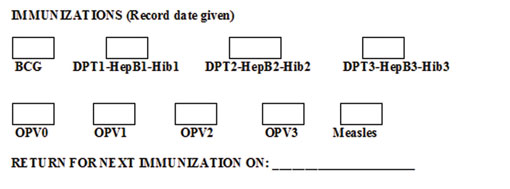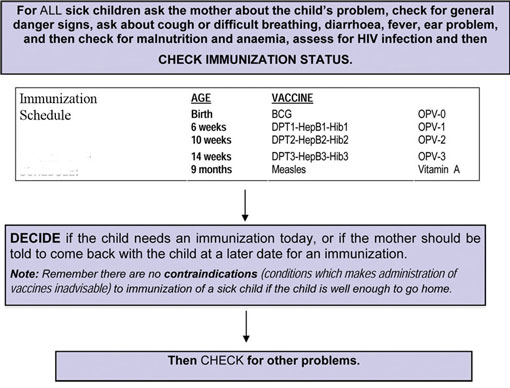12.3 How to check for immunization status
You must check the immunization status of all the children who visit your health post or when you visit them at home. You can use the Assess and Classify chart to help you find the recommended immunization schedule. Box 12.1 outlines the steps you need to take to check the immunization status of each child.
Why is it important to check the immunization status of all children under 24 months old?
Immunization is the most effective strategy for decreasing childhood morbidity and mortality. It can reduce and control illness, disability or death caused by vaccine-preventable diseases.
What dose of OPV would you give to a six-week-old baby who did not receive OPV when born? What are the reasons for your answer?
You would give OPV1. OVPO should not be given to an infant who is more than 14 days old. You would also give the six-week-old infant the DPT1-HepB1-Hib1 vaccination.
In order to decide whether the child needs immunizing right away, you should look at the child’s age on the clinical record. If you do not have this, ask the mother about the child’s age.
ASK the mother if the child has an immunization card. If the mother answers yes, ask her if she has brought the card with her to the health post.
- If she has brought the card with her, ask to see the card.
- Compare the child’s immunization record with the recommended immunization schedule. Decide whether the child has had all the immunizations recommended for the child’s age.
- On the recording form, check all immunizations the child has already received. Write the date of the immunization the child received most recently. Circle any immunizations the child needs in the current visit. These will be any vaccines the child should have already received but has not. For example, if a nine-week-old infant has not yet been vaccinated with DPT1-HepB1-Hib1 and OPV1 (which he should have received at six-weeks-old), you should give the child these vaccines while he is at the health post.
- If the child is not being referred, the mother needs to be advised that the child should receive the relevant immunization (or immunizations) during the visit.
If the mother does not have an immunization card and you have any doubts about what vaccines the child has received, immunize the child.
If the mother says that she does not have an immunization card with her:
- Ask the mother to tell you what immunizations the child has received.
- Use your judgement to decide if the mother has given a reliable report. If you have any doubt, immunize the child. Give the child OPV, DPT-HepB-Hib and the measles vaccine according to the child’s age.
Give an immunization card (as shown in Box 12.2) to the mother and ask her to bring it with her each time she brings the child to the health post.
Box 12.2 Example of immunization card

So far, you have gone through the eight EPI vaccines, their schedule of administration and how to check immunization status of children. In the next section you will learn the contraindications for vaccination.
12.2 Vaccines covered under EPI and their schedule of administration

